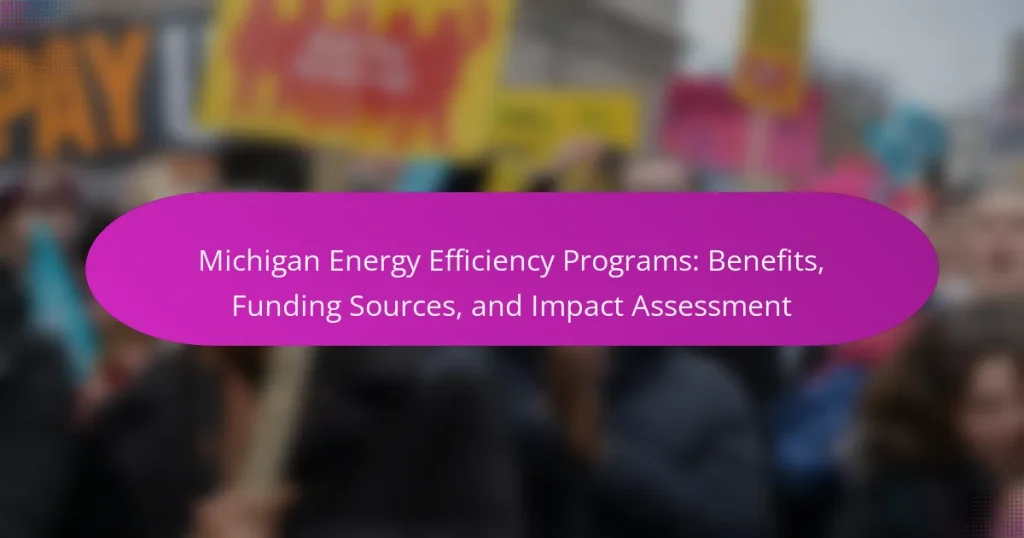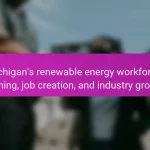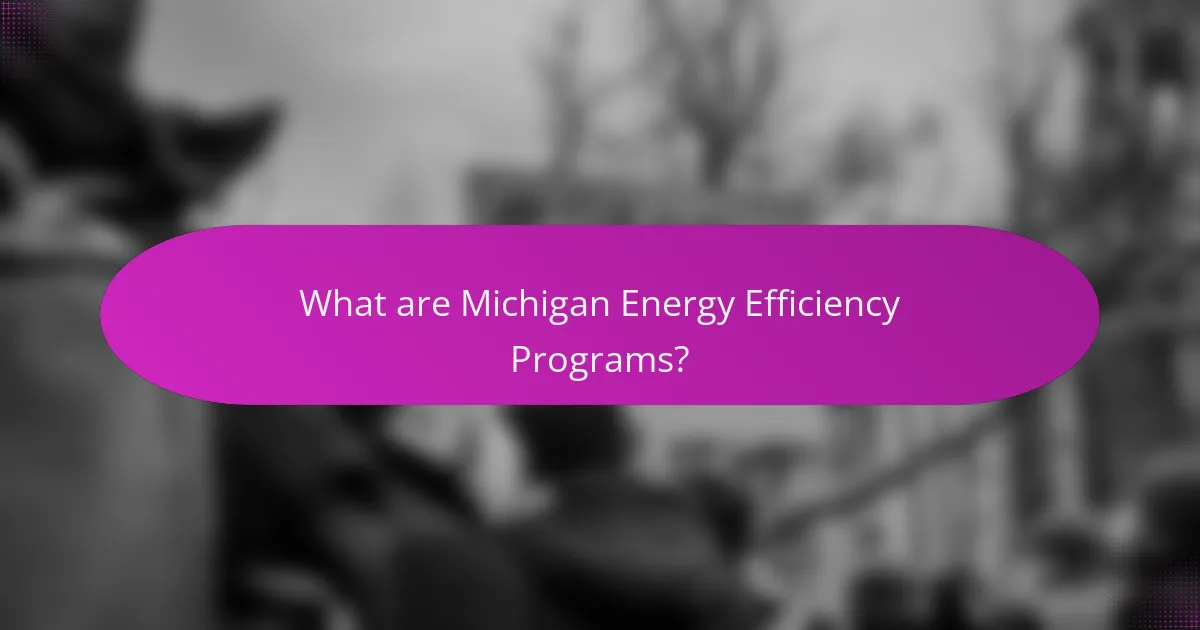
What are Michigan Energy Efficiency Programs?
Michigan Energy Efficiency Programs are initiatives designed to reduce energy consumption across the state. These programs provide resources and incentives for residents and businesses to implement energy-saving measures. They include rebates for energy-efficient appliances, home weatherization assistance, and commercial energy audits. The Michigan Public Service Commission oversees many of these programs. According to the Michigan Energy Office, these initiatives have led to significant reductions in energy usage. In 2020 alone, energy efficiency programs saved over 1.5 billion kilowatt-hours of electricity. This translates to a substantial decrease in greenhouse gas emissions. Overall, these programs aim to promote sustainable energy practices and lower utility costs for consumers.
How do Michigan Energy Efficiency Programs operate?
Michigan Energy Efficiency Programs operate by providing incentives and resources to reduce energy consumption. These programs are designed to help residential, commercial, and industrial sectors improve energy efficiency. They often include rebates, grants, and technical assistance for energy-saving upgrades.
Utilities and state agencies fund these programs, ensuring accessibility and effectiveness. For instance, the Michigan Public Service Commission oversees many of these initiatives. The programs aim to lower energy costs and decrease greenhouse gas emissions. According to the Michigan Energy Efficiency Act, these efforts are expected to achieve significant energy savings across the state.
What key components are involved in these programs?
Key components involved in Michigan Energy Efficiency Programs include energy audits, incentives for energy efficiency upgrades, and educational resources. Energy audits assess a building’s energy use and identify areas for improvement. Incentives often come in the form of rebates or grants to encourage homeowners and businesses to invest in energy-efficient technologies. Educational resources provide information on best practices for energy conservation. These components work together to enhance energy efficiency, reduce costs, and promote sustainable practices in Michigan.
How do these components impact energy consumption?
Energy consumption is impacted by various components of energy efficiency programs. These programs aim to reduce energy use through improved technology and practices. For example, upgrading insulation can decrease heating and cooling demands. Efficient appliances use less electricity while providing the same service. Additionally, smart meters enable better energy management by providing real-time usage data. Research shows that Michigan’s energy efficiency programs have led to a 2% reduction in overall energy consumption since their implementation. This reduction translates to significant cost savings for consumers and decreased environmental impact.
What are the primary benefits of Michigan Energy Efficiency Programs?
Michigan Energy Efficiency Programs primarily benefit residents and businesses by reducing energy costs. These programs help lower utility bills through energy-saving measures. Participants often receive rebates and incentives for implementing energy-efficient upgrades. Additionally, these initiatives contribute to environmental sustainability by decreasing greenhouse gas emissions. The programs also enhance energy reliability by reducing demand on the power grid. According to the Michigan Public Service Commission, energy efficiency programs saved consumers over $1 billion in energy costs from 2009 to 2019. This demonstrates the financial and environmental impact of these programs on the state.
How do these programs contribute to cost savings for residents?
Michigan energy efficiency programs contribute to cost savings for residents by reducing energy consumption and lowering utility bills. These programs offer incentives for energy-efficient appliances and home upgrades. Residents can receive rebates for installing energy-efficient lighting, heating, and cooling systems. Additionally, programs often include free energy audits to identify savings opportunities. According to the Michigan Public Service Commission, energy efficiency measures can save households an average of $200 annually. By decreasing overall energy demand, these programs also help stabilize energy prices.
What environmental benefits arise from implementing these programs?
Implementing Michigan Energy Efficiency Programs leads to significant environmental benefits. These programs reduce energy consumption, which lowers greenhouse gas emissions. For instance, energy efficiency improvements can decrease carbon dioxide emissions by approximately 1.5 million tons annually. Additionally, less energy use results in reduced air pollutants, improving overall air quality. These programs also promote sustainable practices, leading to better conservation of natural resources. By decreasing reliance on fossil fuels, they contribute to a more sustainable energy future. Overall, the environmental benefits are substantial and measurable, supporting both local ecosystems and global climate goals.
What types of funding sources support Michigan Energy Efficiency Programs?
Michigan Energy Efficiency Programs are supported by various funding sources. These sources include utility company funding, state government allocations, and federal grants. Utility companies often provide financial incentives for energy-saving projects. The state government allocates funds through programs like the Michigan Energy Office. Federal grants from agencies such as the Department of Energy also contribute to these programs. Additionally, non-profit organizations may provide funding for specific energy efficiency initiatives. These funding sources collectively enhance the effectiveness of energy efficiency efforts in Michigan.
How do state and federal grants contribute to program funding?
State and federal grants significantly enhance program funding for Michigan’s energy efficiency initiatives. These grants provide essential financial resources that enable the implementation of various projects. For instance, federal grants from the Department of Energy allocate funds specifically for energy efficiency improvements. State grants, such as those from the Michigan Energy Office, support local initiatives aimed at reducing energy consumption. Together, these funding sources allow programs to cover costs related to research, development, and deployment of energy-saving technologies. Additionally, grants often require matching funds, encouraging local investment and collaboration. This combined funding approach ensures a broader reach and greater impact of energy efficiency programs across Michigan.
What role do utility companies play in financing these initiatives?
Utility companies play a crucial role in financing energy efficiency initiatives in Michigan. They often provide funding through energy efficiency programs mandated by state regulations. These programs aim to reduce energy consumption and lower costs for consumers. Utility companies may offer rebates, incentives, and grants to encourage energy-saving measures. For example, in Michigan, companies like Consumers Energy and DTE Energy allocate millions annually for such programs. This funding supports residential and commercial projects, promoting sustainable practices. By financing these initiatives, utility companies contribute to overall energy savings and environmental benefits.
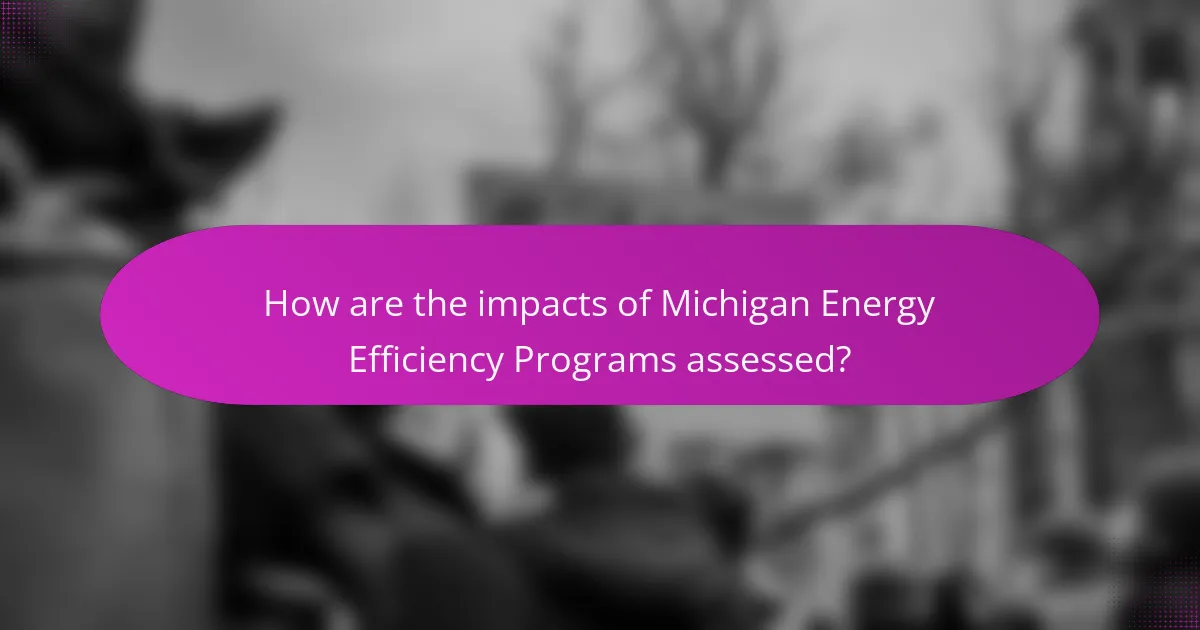
How are the impacts of Michigan Energy Efficiency Programs assessed?
The impacts of Michigan Energy Efficiency Programs are assessed through a combination of methods. These methods include energy savings verification, participant surveys, and cost-benefit analyses. Energy savings verification measures actual reductions in energy consumption resulting from the programs. Participant surveys gather feedback on user experiences and satisfaction levels. Cost-benefit analyses evaluate the economic impacts of the programs, comparing costs to the benefits derived from energy savings. The Michigan Public Service Commission oversees these assessments to ensure accuracy and transparency. This systematic approach helps in understanding the effectiveness of energy efficiency initiatives in Michigan.
What metrics are used to evaluate program effectiveness?
Metrics used to evaluate program effectiveness include energy savings, cost-effectiveness, participant satisfaction, and environmental impact. Energy savings are quantified in kilowatt-hours (kWh) or therms saved. Cost-effectiveness is assessed through the ratio of benefits to costs, often using the Total Resource Cost (TRC) test. Participant satisfaction is measured through surveys that gauge user experience and engagement. Environmental impact is evaluated based on reductions in greenhouse gas emissions. These metrics provide a comprehensive analysis of program performance and guide improvements.
How do these metrics reflect energy savings?
Metrics reflect energy savings by quantifying reductions in energy consumption. They track changes in usage before and after implementing energy efficiency measures. For example, a 20% decrease in electricity usage indicates significant savings. Metrics also include cost savings, showing reduced utility bills. Data from Michigan’s energy programs demonstrate these savings through annual reports. A 2020 assessment revealed that participants saved an average of $200 annually. These metrics provide concrete evidence of the effectiveness of energy efficiency initiatives.
What methodologies are employed in impact assessments?
Impact assessments employ various methodologies to evaluate the effects of projects or policies. Common methodologies include cost-benefit analysis, which compares the costs and benefits of a project. Another method is the logic model, which outlines the relationships between resources, activities, and outcomes. Surveys and stakeholder interviews gather qualitative data on perceptions and experiences. Environmental impact assessments focus on ecological effects, while social impact assessments evaluate community impacts. These methodologies provide a comprehensive understanding of potential impacts, guiding decision-making processes.
What challenges do Michigan Energy Efficiency Programs face?
Michigan Energy Efficiency Programs face several significant challenges. Limited funding restricts the scope and effectiveness of these programs. Regulatory barriers can hinder the implementation of new initiatives. Additionally, public awareness and participation remain low, impacting program uptake. Competition for resources with other energy initiatives complicates prioritization. Furthermore, fluctuating energy prices can affect program viability and funding stability. Lastly, measuring the long-term impact of efficiency measures presents methodological difficulties. These challenges collectively impede the success of energy efficiency initiatives in Michigan.
How do regulatory changes affect program implementation?
Regulatory changes significantly impact program implementation by altering compliance requirements and funding availability. These changes can lead to adjustments in program design and delivery methods. For instance, stricter regulations may necessitate additional reporting or documentation processes. Conversely, more lenient regulations could streamline operations and reduce administrative burdens. In Michigan, energy efficiency programs must adapt to evolving state mandates, such as the Clean and Renewable Energy Standard. This adaptation often influences the allocation of resources and prioritization of specific initiatives. Programs that fail to align with new regulations may face penalties or reduced funding. Therefore, staying informed about regulatory developments is crucial for effective program execution.
What barriers exist to participation in these programs?
Barriers to participation in Michigan Energy Efficiency Programs include lack of awareness and understanding of program benefits. Many potential participants are unaware of available resources and incentives. Financial constraints also play a significant role. Upfront costs for energy-efficient upgrades can deter participation. Additionally, complicated application processes may discourage individuals and businesses from applying. Limited access to information and technical assistance further exacerbates these challenges. According to a report by the Michigan Public Service Commission, these barriers significantly impact overall program enrollment and effectiveness.
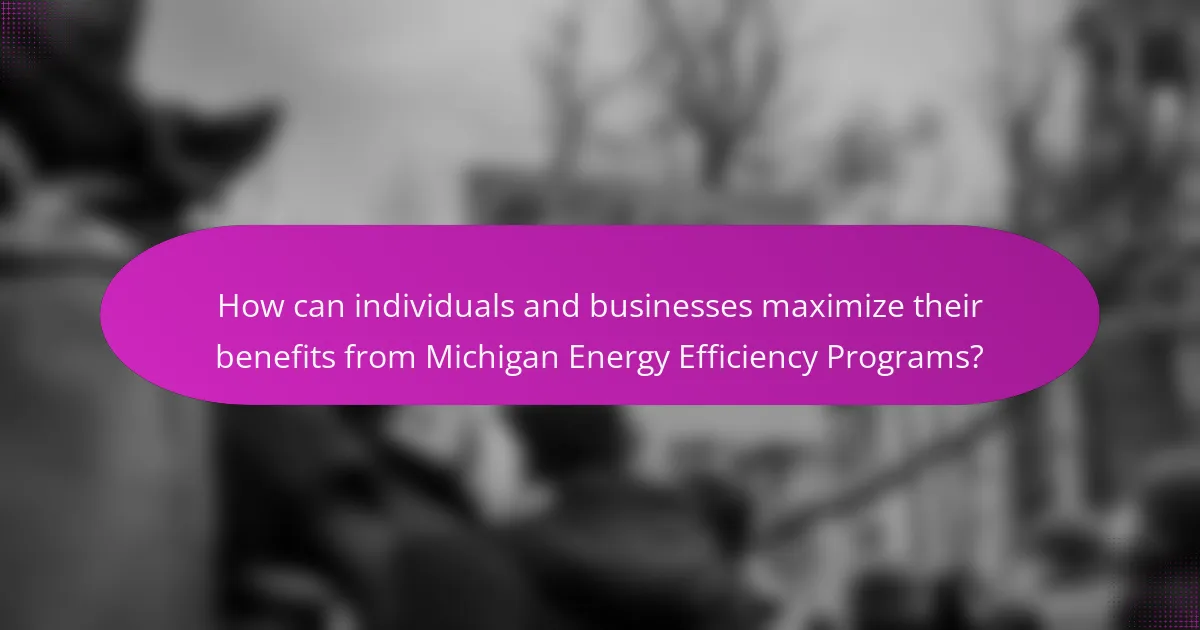
How can individuals and businesses maximize their benefits from Michigan Energy Efficiency Programs?
Individuals and businesses can maximize their benefits from Michigan Energy Efficiency Programs by actively participating in available initiatives. They should first assess their energy consumption to identify areas for improvement. Utilizing energy audits provided by utility companies helps pinpoint inefficiencies.
Next, applying for rebates and incentives can significantly reduce upfront costs for energy-efficient upgrades. Programs often offer financial assistance for purchasing energy-efficient appliances and systems.
Moreover, staying informed about program updates and new offerings is crucial. Regularly checking utility websites or subscribing to newsletters ensures access to the latest opportunities.
Finally, collaborating with local energy efficiency organizations can provide additional resources and support. These organizations often facilitate workshops and training sessions to enhance understanding of energy-saving practices.
By following these steps, individuals and businesses can effectively leverage Michigan’s Energy Efficiency Programs to maximize their benefits.
What steps can residents take to engage with these programs?
Residents can engage with Michigan Energy Efficiency Programs by first researching available programs through official state websites. They can identify specific energy-saving initiatives that suit their needs. Next, residents should apply for participation, often requiring filling out an online application or contacting local energy providers. Many programs offer free energy assessments to evaluate home efficiency. Residents may also attend community workshops or informational sessions to learn about energy-saving practices. Engaging with local advocacy groups can provide additional resources and support. Finally, residents should track their energy usage to measure the impact of the programs they participate in.
How can businesses leverage available incentives for energy efficiency upgrades?
Businesses can leverage available incentives for energy efficiency upgrades by identifying and applying for state and federal programs. These programs often provide financial assistance, tax credits, and rebates for energy-efficient equipment and retrofits. For instance, Michigan offers programs through utilities that can cover a significant portion of upgrade costs. Businesses should conduct an energy audit to determine specific needs and potential savings. Engaging with local utility companies can provide insights into available incentives. Additionally, staying informed about changes in legislation can reveal new funding opportunities. By strategically planning upgrades, businesses can maximize their financial benefits while reducing energy consumption.
What are some best practices for optimizing energy efficiency in Michigan?
Implementing energy-efficient practices is essential for optimizing energy use in Michigan. Homeowners should consider upgrading insulation to reduce heating and cooling costs. Installing energy-efficient windows can significantly lower energy bills. Utilizing programmable thermostats helps manage energy consumption effectively. Regular maintenance of heating and cooling systems ensures optimal performance. Transitioning to LED lighting reduces electricity usage. Utilizing energy-efficient appliances can lead to substantial savings over time. Participating in local energy efficiency programs can provide financial incentives and support. According to the Michigan Public Service Commission, energy efficiency programs have saved consumers over $1 billion since 2009.
Michigan Energy Efficiency Programs are initiatives aimed at reducing energy consumption throughout the state, providing resources and incentives for both residents and businesses to adopt energy-saving measures. Key components of these programs include energy audits, rebates for energy-efficient appliances, and educational resources, all overseen by the Michigan Public Service Commission. The article will explore the operational mechanisms, primary benefits, funding sources, impact assessment methodologies, and challenges faced by these programs, as well as actionable steps for individuals and businesses to maximize their participation and benefits. Additionally, it highlights the significant environmental and financial impacts these programs have achieved, including substantial reductions in energy usage and greenhouse gas emissions.
